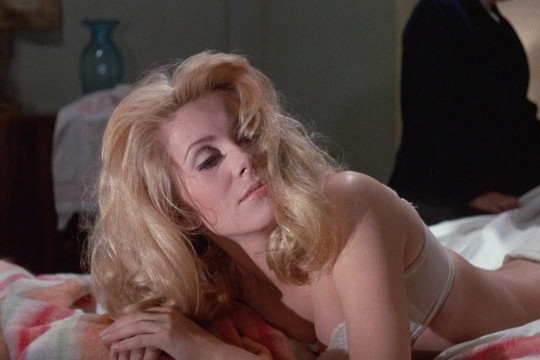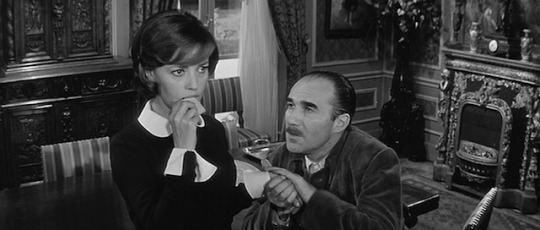#Louisette Hautecoeur
Explore tagged Tumblr posts
Photo

Catherine Deneuve in Belle de Jour (Luis Buñuel, 1967)
Cast: Catherine Deneuve, Jean Sorel, Michel Piccoli, Geneviève Page, Pierre Clémenti, Françoise Fabian, Macha Méril, Muni, Maria Latour, Georges Marchal. Screenplay: Luis Buñuel, Jean-Claude Carrière, based on a novel by Joseph Kessel. Cinematography: Sacha Vierny. Production design: Robert Clavel. Film editing: Louisette Hautecoeur.
Belle de Jour is a famously enigmatic film, venturing into (and often blurring) the space between reality and fantasy, between waking life and dreams. It has led a lot of people astray, into questions like: What's buzzing in the Asian client's box that so frightens the other prostitutes in the brothel, but so satisfies Séverine (Catherine Deneuve)? Why does Séverine so often hear cats meowing? What is the Duke (Georges Marchal) doing that so shakes the coffin in which he has posed Séverine and causes her to flee into the rain? Why is Pierre (Jean Sorel) so fascinated by the wheelchair that foreshadows his fate? How much of any of this is meant to be reality? Critics have been more or less preoccupied by these and other matters of speculation and interpretation for more than 50 years. Of course, it would be abrogating the critics' responsibility if they failed to pursue the aesthetic and moral effects of the enigmas introduced into the film by Luis Buñuel and screenwriter Jean-Claude Carrière. But their effect is collective and cumulative, and pursuing any one of these details in search of a definitive answer is like concentrating on the threads at the expense of seeing the tapestry. Belle de Jour is subject to all forms of analysis -- Freudian, Jungian, Lacanian, Marxist, feminist, you name it -- but without exhausting its possibilities to tantalize. Buñuel's major achievement in the film is in sticking to his roots in surrealism without resorting to surrealist clichés: Every scene, even the obvious fantasies like the one in which Séverine is pelted with muck by Pierre and Husson (Michel Piccoli), is grounded in actuality, down to the specific address and the mundane Parisian location given to the brothel run by Madame Anaïs (Geneviève Page). It's only in reflecting on the film that we begin to question which scenes are "real" and which aren't. Belle de Jour is one of those inexhaustible films that you revisit with the certain knowledge that it will look slightly different to you every time.
7 notes
·
View notes
Photo










The Milky Way (Luis Buñuel, 1969).
#la vía láctea#la voie lactée#luis buñuel#jean-claude carrière#christian matras#louisette hautecoeur#pierre guffroy#jacqueline guyot#pierre cadiou#laurent terzieff
81 notes
·
View notes
Photo

It's strange, how the country always seems sad. I guess, people don't have much fun here.
Diary of a Chambermaid (Le journal d'une femme de chambre), Luis Buñuel (1964)
#Luis Buñuel#Jean Claude Carrière#Jeanne Moreau#Georges Géret#Michel Piccoli#Françoise Lugagne#Jean Ozenne#Daniel Ivernel#Gilberte Géniat#Bernard Musson#Dominique Sauvage#Roger Fellous#Louisette Hautecoeur#1964
31 notes
·
View notes
Photo

Jeanne Moreau and Michel Piccoli in Diary of a Chambermaid (Luis Buñuel, 1964) Cast: Jeanne Moreau, Georges Géret, Daniel Ivernel, Françoise Lugagne, Muni, Jean Ozenne, Michel Piccoli. Screenplay: Luis Buñuel, Jean-Claude Carrière, based on a novel by Octave Mirbeau. Cinematography: Roger Fellous. Production design: Georges Wakhévitch. Film editing: Louisette Hautecoeur. Jeanne Moreau's aura of knowingness serves as a filter through which we view the Monteil household in Luis Buñuel's sharp-edged satire on wealth and privilege.
1 note
·
View note
Photo

Gérard Philipe and Michèle Morgan in Les Grandes Manoeuvres (René Clair, 1955) Cast: Michèle Morgan, Gérard Philipe, Jean Desailly, Yves Robert, Brigitte Bardot, Pierre Dux, Jacques Fabbri. Screenplay: René Clair, Jérôme Géronimi, Jean Marsan. Cinematography: Robert Lefebvre. Production design: Léon Barsacq. Film editing: Louisette Hautecoeur, Denise Natot. Music: Georges Van Parys. René Clair's first film in color is a pretty pastel confection set in a French village at the end of the 19th century, a period many French filmmakers were drawn to in part because it held a kind of autumnal glow before the harsh winter that would set in during the second decade of the 20th century. A handsome womanizing lieutenant, Armand de la Verne, stationed in the village before the beginning of the army's summer maneuvers, wagers that he can seduce the first woman to enter the room. She happens to be Marie-Louise Rivière, a divorcée who has opened a millinery in the village. And they happen to be played by Gèrard Philipe and Michèle Morgan, two of the biggest French stars of the day, both of them in middle age and endowed with a kind of gravitas that means the movie is not going to be a frivolous sex farce. For sexiness, we have a parallel flirtation between another lieutenant, Félix Leroy (Yves Robert), and the saucy young Lucie, played by the saucy young Brigitte Bardot. Yet the film is weighed down by the more mature couple, to the point that Clair's romantic nostalgia never quite comes off the screen and engages the audience. It's lovely to look at, and it has admirers who defend its bittersweet tone, but it feels to me more like an exercise in period filmmaking than a fully committed work -- even though it was one of Clair's favorite films.
0 notes